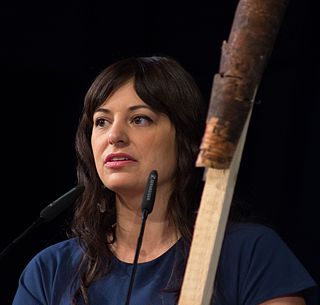External links
- Iris Taylor Official Site Archived 2018-06-03 at the Wayback Machine
- The Centre for Contemporary Canadian Art Profile of Kay Burns
Kay Burns is a multidisciplinary artist based in Fogo Island, Newfoundland.
Burns's work includes: performance art, locative media, audio, video, photography, sculpture, and installation. Her practice engages in site-specific responses to locations through a reinterpretation of local mythologies, histories, and the eccentricities of people who inhabit those places. Her work melds fact and fiction through alternative constructions of place and event, indirectly commenting on the authority associated with the dissemination of information.
A significant part of Burns’s practice has been the reinstatement of the defunct Flat Earth Society of Canada through her performance persona, Iris Taylor, entailing presentations of an evolving 'recruitment lecture' and the ongoing development of flat earth artifacts. Her performance work also includes guided 'historical' walks as Iris Taylor, and an extended walking practice through her involvement as a founding member of the Ministry of Walking collective. Her work has been presented internationally in Reykjavík, Amsterdam, Belfast, New York City, and Los Angeles; and across Canada from Dawson to St. John's.
Burns previously held the post of curator at the Muttart Public Art Gallery in Calgary, and taught in the University of Calgary Fine Arts Department and the Alberta College of Art and Design Media Art Department prior to her move to Newfoundland. Burns continues to undertake freelance writing and curatorial projects, as well as mentorship and visiting teaching roles for various organizations and institutions.
Parkdale is a mature, inner city neighbourhood in the city of Calgary, Alberta along the north bank of the Bow River between the communities of West Hillhurst and Point McKay. It is bounded on the south by the Bow River, 28 St NW to the east, Shaganappi Trail NW to the west and on the north by 16th Avenue. Parkdale is in close proximity to both the Foothills Medical Centre and the Alberta Children's Hospital constructed in 2006, as well as the University of Calgary. Memorial Drive provides access to downtown Calgary and to Highway 1 which leads to the Rocky Mountains. Parkdale was annexed to the City of Calgary in 1910 when Calgary began to experience a "major economic and building boom." The boom ended in 1913 and further development of the Parkdale Addition as it was called, was halted because of World War I. Following World War II in the 1950s the dominant housing type that characterized Parkdale, was the bungalow. By 2014 Parkdale, like other inner city communities in Calgary, was experiencing gradual gentrification with small cottage-style bungalows being replaced by spacious flat roofed, Prairie School Frank Lloyd Wright inspired infills attracting young families with children away from the long commute suburbs to inner city ease of access to downtown, transit and work.
Sarah Peebles is a Toronto-based Canadian - American composer, improviser and installation artist originally from Minnesota (USA). Much of her work explores digitally manipulated found sound, unconventional methods of amplification, and distinct approaches to improvisation on the shō (笙), the Japanese mouth-organ used in gagaku. Her installation practice focuses on BioArt which explores the lives of native wild bees, pollination ecology and biodiversity. Collectively titled “Resonating Bodies”, much of this activity is in collaboration with other artists, technicians and bee biologists.
Don Simmons is a Canadian experimental artist and writer whose work materializes itself as robotics, electronics, audio, installation and performance.

Iris Haeussler is a conceptual and installation art artist of German origin. She lives in Toronto, Canada. Many of Iris Haeussler's works are detailed, hyperrealistic installations that visitors can decode as narrative stories. Recurring topics in her work include historic, cultural, social and geographic origins; family ties, relationships, memory, history, trauma and obsession.
Kate Armstrong is a Canadian artist, writer and curator with a history of projects focusing on experimental literary practices, networks and public space.
Mireille Eagan is a Canadian arts writer and curator.
Ernesto Pujol is a site-specific performance artist, social choreographer, and educator with an interdisciplinary practice. Pujol was born in 1957 in Havana, Cuba and spent time in San Juan, Puerto Rico, and in Madrid and Barcelona, Spain, before moving to the United States in 1979. He has lived and worked in New York since 1984. Pujol engaged in interdisciplinary pursuits, such as psychology and literature, while doing undergraduate work in humanities and visual arts at the University of Puerto Rico, in Spanish art history at the Universidad Complutense in Spain and in philosophy at St. John Vianney College Seminary in Florida. He pursued graduate work in education at the Universidad Interamericana in San Juan, Puerto Rico, in art therapy at Pratt Institute in Brooklyn, and in communications and media theory at Hunter College in New York City. Pujol received his MFA in interdisciplinary art practice from the School of the Art Institute of Chicago.

The Banff Park Museum National Historic Site, located in downtown Banff, Alberta, is an exhibition space associated with Banff National Park.
A superfiction is a visual or conceptual artwork that uses fiction and appropriation to blur the lines between facts and reality about organizations, business structures, and/or the lives of invented individuals.
Barb Hunt is a multidisciplinary textile artist from Winnipeg, Manitoba. Her art has contrasted knitting as a warming, protective art, against the violence of war. Through her tactile work, Hunt explores domesticity, mourning rituals, the natural world, and the colour pink.

Cheryl L'Hirondelle is a Canadian multidisciplinary media artist, performer, and award-winning musician. She is of Métis/Cree (non-status/treaty), French, German, and Polish descent. Her work is tied to her cultural heritage. She explores a Cree worldview or nêhiyawin through body, mind, emotions, and spirit; examining what it means to live in contemporary space and time.
Barbara Meneley is a contemporary Canadian visual artist and educator based in Regina, Saskatchewan. She is known for her new media art, which brings together elements of media, installation art and performance art in solo and curated group exhibitions throughout Canada.

The art of Newfoundland and Labrador has followed a unique artistic trajectory when compared to mainland Canada, due to the geographic seclusion and socio-economic history of the province. Labradorian art possesses its own historical lineage.

Elizabeth MacKenzie is a Canadian artist based in Vancouver known for her drawing, installation and video since the early eighties. MacKenzie uses drawing to explore the productive aspects of uncertainty through the use of repetition, interrogations of portraiture and considerations of intersubjective experience. Her work has been characterized by an interest in maternal ambivalence, monstrous bodies, interrogations of portraiture and considerations of the complexity of familial and other interpersonal relations.
Nancy Tousley is a senior art critic, journalist, art writer and independent curator whose practice has included writing for a major daily newspaper, art magazines, and exhibition catalogues.

Candice Hopkins is a Carcross/Tagish First Nation independent curator, writer, and researcher who predominantly explores areas of indigenous history, and art.

Heather L. Igloliorte is an Inuk scholar, independent curator and art historian from Nunatsiavut.
Mary Macdonald was a Canadian artist and independent curator based in St. John’s, who left a lasting impact on the arts and cultural community of Atlantic Canada, and advocated for the promotion of emerging artists and cultural workers in the region.
The Museum of the Flat Earth is a small museum dedicated to the history of the Canadian Flat Earth Society, located on Fogo Island, Newfoundland. It has a variety of historical collections covering the life of Bartholomew Seeker, as well as other individuals associated with the Canadian Flat Earth Society, and a series of more contemporary displays which deal with debates around the notion of a Flat Earth.
Sally McKay is a Canadian artist, curator, writer, educator, and personal art coach based in Hamilton, Ontario. McKay is known for her work as an artist of many forms and her research, which explores cognition, consciousness and social structures with a particular interest in the intersections between art and science. McKay has worked in a variety of media including performance, installation and digital art. She is also a widely recognized educator and art coach known for her collaborative work and has worked at a number of Canadian universities. Alongside her work as an artist and researcher, McKay is a writer. McKay has written for, founded and edited several publications and magazines, most notably Lola.